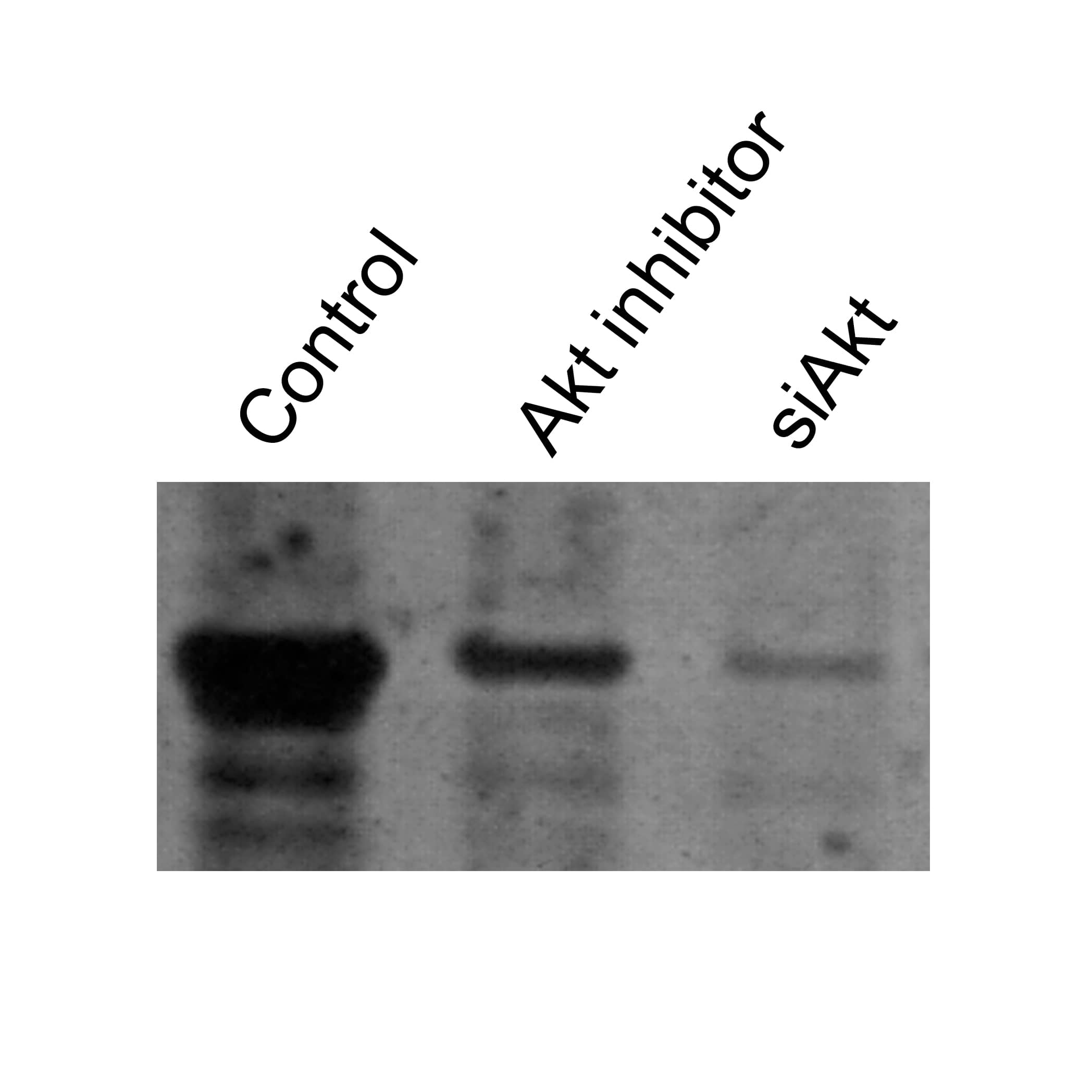| Reactivity | Hu, Mu, RtSpecies Glossary |
| Applications | WB, Simple Western, IHC, CyTOF-ready, Flow, ICC/IF |
| Clone | 281046 |
| Clonality | Monoclonal |
| Host | Mouse |
| Conjugate | Unconjugated |
| Concentration | LYOPH |
| Immunogen | E. coli-derived recombinant human Akt1 Ser2-Ala480 Accession # P31749 |
| Specificity | Detects human, mouse and rat Akt in direct ELISAs and Western blots. |
| Source | N/A |
| Isotype | IgG2b |
| Clonality | Monoclonal |
| Host | Mouse |
| Gene | AKT1 |
| Purity Statement | Protein A or G purified from hybridoma culture supernatant |
| Innovator's Reward | Test in a species/application not listed above to receive a full credit towards a future purchase. |
| Dilutions |
|
|
| Application Notes | In Simple Western only 10-15 uL of the recommended dilution is used per data point. |
|
| Reviewed Applications |
|
|
| Publications |
|
| Storage | Use a manual defrost freezer and avoid repeated freeze-thaw cycles.
|
| Buffer | Lyophilized from a 0.2 μm filtered solution in PBS with Trehalose. *Small pack size (SP) is supplied either lyophilized or as a 0.2 µm filtered solution in PBS. |
| Preservative | No Preservative |
| Concentration | LYOPH |
| Reconstitution Instructions | Reconstitute at 0.5 mg/mL in sterile PBS. |
Akt, also known as protein kinase B (PKB), is a central kinase in such diverse cellular processes as glucose uptake, cell cycle progression, and apoptosis. Three highly homologous members define the Akt family: Akt1 (PKB alpha ), Akt2 (PKB beta ), and Akt3 (PKB gamma ). All three Akts contain an amino-terminal pleckstrin homology domain, a central kinase domain, and a carboxyl-terminal regulatory domain.
| Images | Ratings | Applications | Species | Date | Details | ||||||
|---|---|---|---|---|---|---|---|---|---|---|---|

Enlarge |
reviewed by:
Ronald Miller |
WB | Human | 12/12/2014 |
Summary
|
Secondary Antibodies |
Isotype Controls |
|
Insulin signaling in adipocytes: Carbohydrate-signaling transcription factor ChREBP is the link between lipolytic enzyme Hormone-Sensitive Lipase and lipogenic enzyme ELOVL6 By Jamshed Arslan, Pharm. D., PhD. Insulin resistance in adipocytes is a major feature of metabolic syndrome . Disrupted adipose tissue metabolism can lead to accumulation of lipid intermediates in insul... Read full blog post. |
|
mTOR Signaling and the Tumor Microenvironment By Yoskaly Lazo-Fernandez, PhD The mammalian target of rapamycin (mTOR) is a conserved serine/threonine kinase that, as a member of two distinct intracellular protein complexes, mTORC1 and mTORC2, regulates protein ... Read full blog post. |
|
Novel Insights into Hypoxia Induced AKT Signaling Hypoxia is a common feature of most tumors and is a product of rapid cell growth and poor vascularization1. When oxygen availability is low in the tumor environment, the hypoxia inducing transcription factors (HIFs) regulate a variety of signaling ... Read full blog post. |
|
Pathway Highlight: Three key factors that contribute to cellular heterogeneity in apoptosis Have you ever wondered why cells in the same population respond differently to an apoptotic stimulus? Apoptosis, a form of programmed cell death, is vital for the removal of unwanted or damaged cells. As with most cellular processes, too much or to... Read full blog post. |
|
The role of c-Fos in the regulation of the JC virus gene transcription c-Fos is a member of the AP-1 transcription factor family under the Fos protein family umbrella, alongside Fra-1, Fra-2 and Fos-B. Also in the AP-1 transcription family are the Jun proteins, c-Jun, Jun-B and Jun-D. Each member of the AP-1 transcri... Read full blog post. |
|
Pathway Highlight: Which caspase substrates contribute to the morphological features associated with apoptosis? Apoptosis, or programmed cell death, is controlled by a caspase signal cascade that activates downstream signals to induce the morphological changes used to differentiate apoptosis from other forms of cell death. Novus Biologicals offers a variet... Read full blog post. |
|
The use of apoptosis antibodies and controls in cell death research Apoptosis is a method of programmed cell death that is notably characterized by a morphological change in cellular nuclei and membrane appearance. Not to be confused with necrosis, apoptosis is a pathway that is induced by a variety of factors tha... Read full blog post. |
|
The role of Parkin and autophagy in retinal pigment epithelial cell (RPE) degradation The root of Parkinson’s disease (PD) points to a poorly regulated electron transport chain leading to mitochondrial damage, where many proteins need to work cohesively to ensure proper function. The two key players of this pathway are PINK1, ... Read full blog post. |
|
The effects of curcumin on IKB Alpha and the NFkB signaling pathway The IKK complex, or inhibitor of NFkB kinase, is composed of IKK alpha and IKK beta. These kinases are at the core of the NFkB signaling cascade. The NFkB family is made up of transcription factors that are kept inactive in the cytoplasm through... Read full blog post. |
|
AMPK Alpha 1 and lipid metabolism of adipocytes AMP-activated protein kinase (AMPK) is best known as a sensor of oxidative stress. AMPK is activated by increased intracellular AMP levels, which are a result of alterations in cellular metabolism from causes such as hypoxia, changes in ATP, sene... Read full blog post. |
The concentration calculator allows you to quickly calculate the volume, mass or concentration of your vial. Simply enter your mass, volume, or concentration values for your reagent and the calculator will determine the rest.